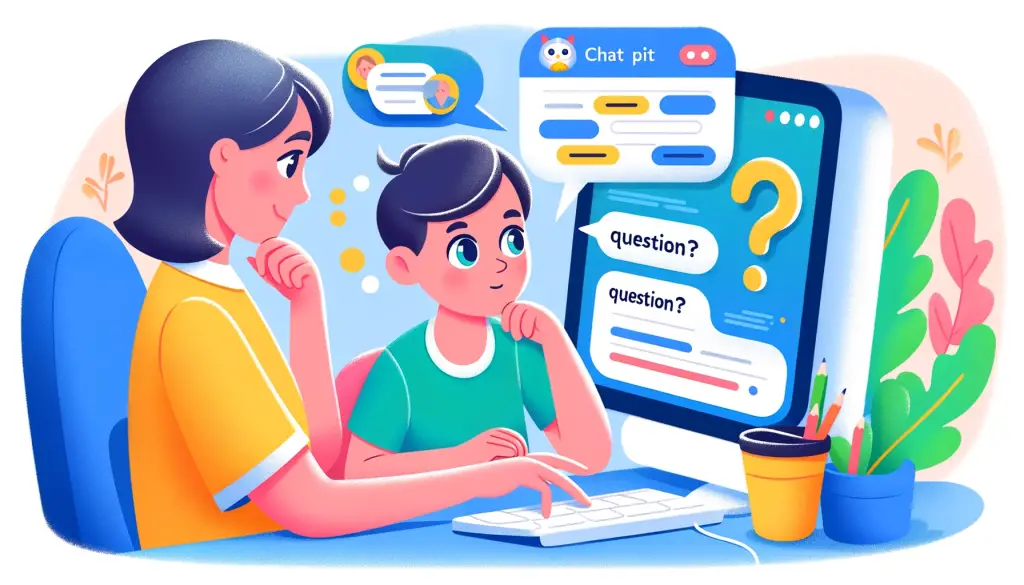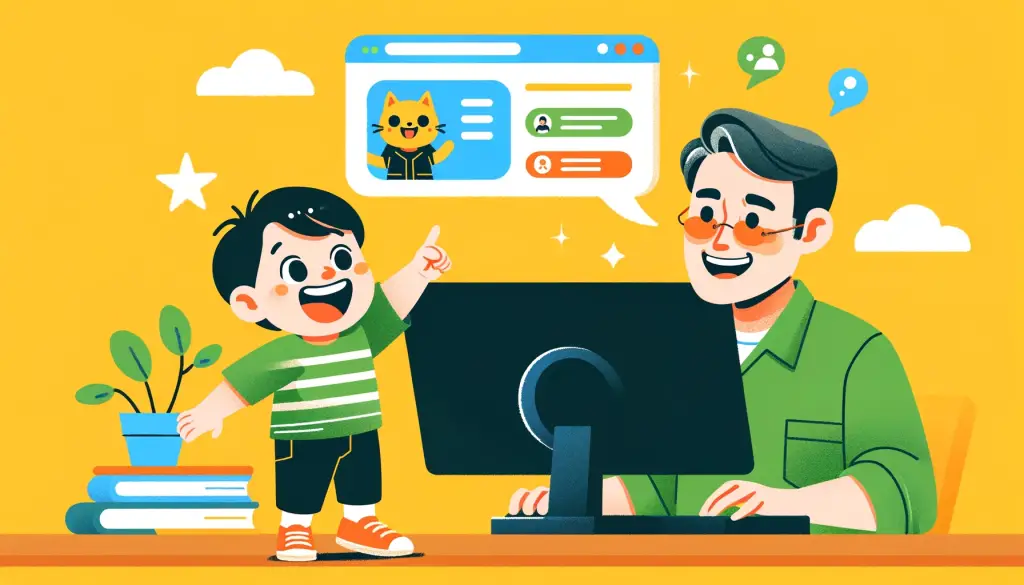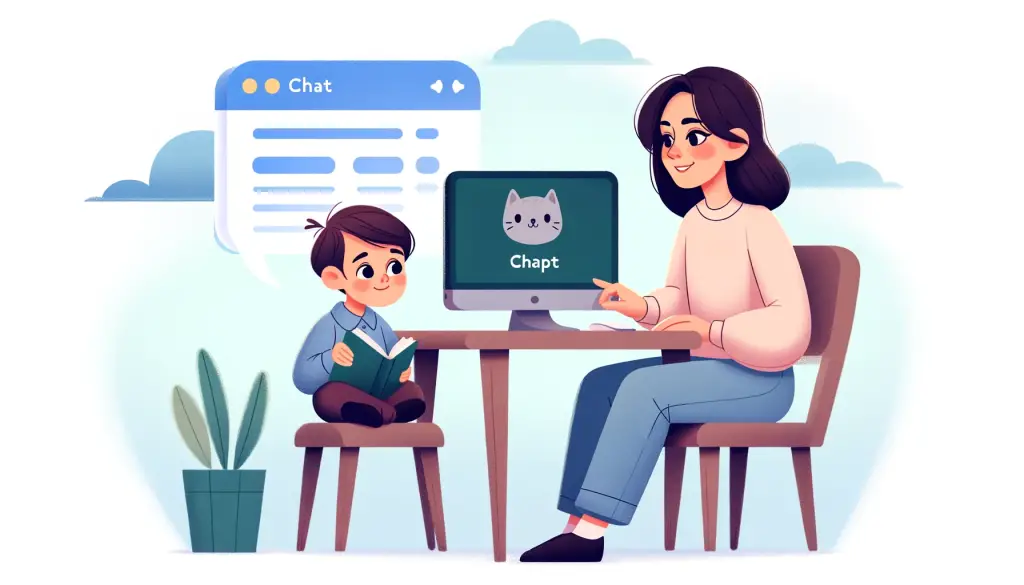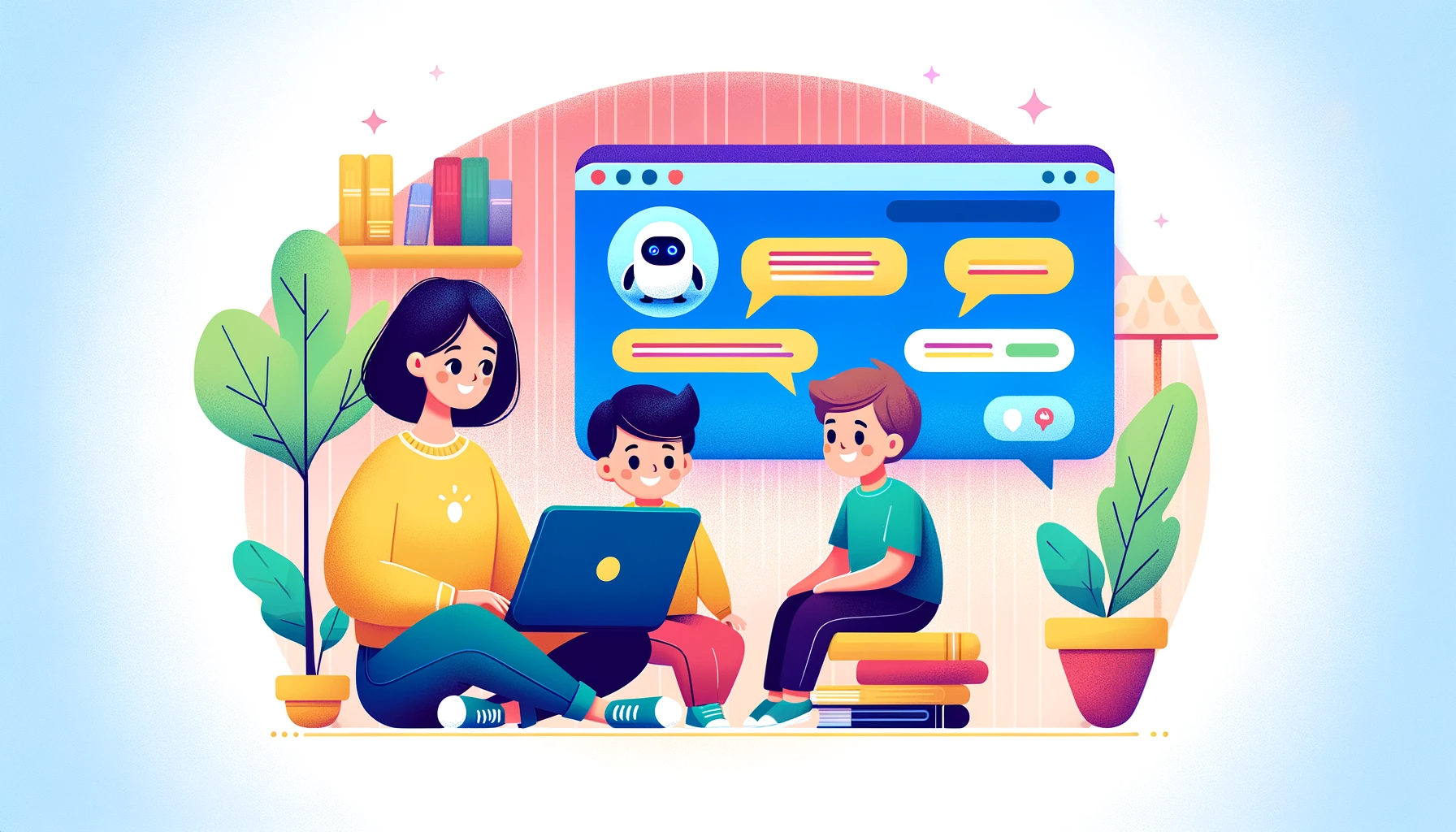In the modern parenting toolkit, ChatGPT emerges as a novel asset. This AI, known for its efficiency in content creation, offers more than just a rapid writing solution or brainstorming tool. It stands out as a thoughtful entity, a far cry from the typical, superficial online chatter.
Bridging the Gap to Profound Insights
ChatGPT, while not possessing the depth of spiritual texts or the eloquence of renowned poets and philosophers, adeptly synthesizes their wisdom. This ability is particularly beneficial for parents. When children pose complex questions, ChatGPT can provide responses that sound plausible and are enriched with context and nuance, often offering perspectives parents themselves might not consider.
Access to a World of Wisdom
ChatGPT, through its extensive database, accesses a diverse range of wisdom from various sources. It can cull knowledge from historical texts, famous literary works, and philosophical discourses. This eclectic mix provides a rich tapestry of information, enabling ChatGPT to offer well-rounded, informed responses that might be beyond the typical reach of busy parents.
Tailoring Complex Concepts for Young Minds
ChatGPT excels in breaking down sophisticated ideas into simpler, more digestible forms, suitable for children’s understanding. This ability is particularly useful when discussing delicate topics such as life and death. For instance, when a child inquires about death rituals or asks what wood caskets are, ChatGPT can provide age-appropriate explanations. These explanations help children grasp and engage with concepts that would otherwise be out of their cognitive reach. The goal is to translate complex realities like the significance of wood caskets in funerals, into a language that is sensitive yet understandable for a young audience.
Enriching Conversations with Diverse Perspectives
One of the most significant advantages of using ChatGPT is the introduction of diverse perspectives into the parent-child dialogue. When children ask questions that delve into ethics, morality, or even abstract concepts like love and justice, ChatGPT can offer a range of viewpoints, reflecting the diversity of human thought. This not only enriches the conversation but also encourages children to appreciate multiple perspectives from an early age.
Fostering a Culture of Inquiry and Learning
Using ChatGPT in conversations with children can foster a culture of inquiry and a love for learning. When children see that their questions are taken seriously and answered thoughtfully, it encourages them to ask more, think more critically, and develop a deeper understanding of the world around them. This continuous engagement with an AI tool like ChatGPT can cultivate a lifelong curiosity and eagerness to learn.

Encouraging Creative Exploration
The extensive training set of ChatGPT paves the way for a unique and creative exploration of life’s big questions, a journey that both parents and children can embark on together. This exploration transcends conventional methods, opening doors to a deeper understanding and innovative perspectives on various subjects.
Diving into a Sea of Knowledge
ChatGPT’s vast repository of information encompasses diverse fields, from science and history to art and culture. This diversity allows for an exploration that is not confined to one-dimensional answers. Parents can guide their children through an educational adventure, delving into topics that range from the scientific explanations of the natural world to philosophical musings about human existence.
Crafting Tailored Learning Experiences
One of the key strengths of ChatGPT is its ability to tailor responses based on the prompts it receives. This feature enables parents to customize the learning experience to suit their child’s age, interests, and level of understanding. Whether it’s simplifying a complex concept for a younger child or offering a more detailed explanation for an older one, ChatGPT can adjust its responses accordingly.
Sparking Imagination and Curiosity
By presenting information in various formats, such as stories, analogies, or hypothetical scenarios, ChatGPT can spark imagination and curiosity in children. This approach not only makes learning more engaging but also encourages children to think creatively and develop their problem-solving skills.
Facilitating Interactive Learning
Interactive learning is a critical aspect of child development, and ChatGPT can play a significant role in this. By posing questions, challenging assumptions, and encouraging children to explore different angles of a topic, ChatGPT facilitates a two-way learning process. This interactive approach helps in nurturing critical thinking and analytical skills in children.
Broadening Horizons Beyond Conventional Education
ChatGPT can introduce children to ideas and concepts that they might not encounter in traditional educational settings. This exposure broadens their horizons, giving them a more comprehensive view of the world. It also prepares them to understand and appreciate the diversity of thoughts, cultures, and perspectives that exist globally.
The Journey From Generic to Specific
The interaction with ChatGPT often begins with responses that may seem broad or generic. This is a starting point, a foundation from which the conversation can evolve into something more detailed and tailored. As the dialogue with the AI progresses, it adapts and refines its responses, leading to a more nuanced and contextually rich exchange. This journey from generic to specific is key in enhancing children’s understanding and engagement with various topics.
Initial Engagement: Setting the Stage
In the early stages of interaction, ChatGPT’s responses serve as a primer, setting the stage for deeper exploration. These initial answers provide a basic understanding of the topic, which is especially useful for children who are just beginning to learn about a new subject. This foundational knowledge is essential for building confidence and interest in the topic.
Progression to Detailed Exploration
As the conversation continues, ChatGPT’s responses become more detailed and focused. This is particularly evident when specific follow-up questions are asked. The AI delves into its extensive database to provide more comprehensive answers, often bringing in related concepts and examples that enrich the discussion.
Tailoring Responses to the Learner’s Curiosity
One of the unique aspects of ChatGPT is its ability to tailor responses based on the nature of the queries. When children ask more pointed or detailed questions, the AI recognizes this shift and responds accordingly. This ensures that the information provided matches the child’s level of curiosity and understanding, making the learning process both effective and enjoyable.
Enhancing Comprehension Through Context
Context is crucial for comprehension, especially for young learners. As the responses become more specific, ChatGPT includes relevant examples, analogies, and explanations that put the information into a context children can understand. This not only aids in comprehension but also helps in retaining the information learned.
Encouraging Depth and Breadth in Learning
This journey from generic to specific encourages both depth and breadth in learning. Children are not only able to dive deep into specific aspects of a topic but also explore its broader implications and connections to other areas of knowledge. This holistic approach to learning is instrumental in developing well-rounded knowledge.

Cultivating Critical Thinking
ChatGPT may even help children learn critical thinking skills is paramount. ChatGPT plays a unique role in this process through its nuanced responses that often include limitations and caveats. This aspect of ChatGPT’s functioning is not a flaw but a feature, instrumental in teaching children to approach information critically, recognizing that answers provided by AI are constructed from available knowledge and not absolute truths.
Encouraging Questioning and Skepticism
ChatGPT, by presenting answers with caveats, naturally encourages a questioning mindset. When children see that even an AI tool does not assert absolute certainty, they learn the value of skepticism and inquiry. This approach is in stark contrast to accepting information at face value, fostering a more analytical and discerning mindset.
Differentiating between Facts and Interpretations
One key aspect of critical thinking is the ability to differentiate between objective facts and subjective interpretations. ChatGPT’s responses, which often blend factual information with interpretive insights, serve as practical examples for children to learn this differentiation. It teaches them to identify the difference between what is known and what is conjectured or hypothesized.
Understanding the Contextual Nature of Knowledge
ChatGPT helps children understand that knowledge and answers are often contextual. Responses may vary depending on the framing of the question, the available data, and the perspective from which an answer is derived. This understanding is crucial in today’s world, where context shapes much of the information we encounter.
Developing a Balanced Perspective
The inclusion of limitations in responses allows children to see the value in considering multiple perspectives before forming an opinion. It teaches them that for many questions, especially the complex and profound ones, there are no clear-cut answers but a spectrum of viewpoints. This realization is essential for developing a balanced and open-minded approach to learning and understanding the world.
Nurturing Intellectual Humility
Engaging with ChatGPT can instill a sense of intellectual humility – an understanding that one’s knowledge is always limited and open to revision. This attitude is crucial in a world where new information constantly emerges and where what is considered true today might be revised tomorrow.

Recognizing the Limitations of AI
Despite its advanced capabilities, ChatGPT is not without limitations. Its proficiency in language does not necessarily equate to providing entirely truthful or accurate answers.
Overcoming AI Hallucinations
One of the primary challenges with ChatGPT is its tendency to create plausible narratives that may not be rooted in truth. These are known as hallucinations. This occurs because the AI lacks real-world experience and relies solely on its programmed training set.
Depth of Understanding
ChatGPT’s grasp of profound life questions may be limited. While it references a vast corpus of human knowledge, it might not fully comprehend the intricacies of life, death, and existential realities, especially when answering a child’s questions.
The Necessity of Human Interaction
ChatGPT should not be seen as a replacement for human interaction. While it can provide extensive information, the nuanced understanding and guidance that come from real human engagement are irreplaceable, particularly when addressing complex topics with children.
Best Practices for Using ChatGPT with Kids
Integrating ChatGPT into conversations with children can be a powerful tool for learning and exploration. However, it’s important to approach this integration thoughtfully, ensuring that the interactions are beneficial and align with your family’s values and understanding of the world. Here are some best practices to consider:
Encouraging Open-Ended Questions
- Foster Curiosity: Encourage children to ask open-ended questions that invite expansive answers. This not only engages the AI in producing more thoughtful responses but also stimulates the child’s curiosity and critical thinking.
- Develop Inquiry Skills: Open-ended questions help children learn how to think and inquire, rather than just seek direct answers. This skill is vital for intellectual development and lifelong learning.
Aligning with Family Values
- Screen Content: Ensure that the topics and responses from ChatGPT are in line with your family’s values and beliefs. This might involve previewing questions and answers or discussing the responses with your child to provide context.
- Contextualize AI Responses: Explain to children that while ChatGPT can provide a lot of information, its understanding of human values and emotions is limited and might not always align with personal or family perspectives.
Understanding the AI’s Programmed Nature
- Educate About AI Limitations: Teach children that ChatGPT, while sophisticated, is a programmed tool that operates based on its training data. It does not have personal experiences or emotions.
- Discuss Data Bias: It’s important to make children aware that AI can have biases based on the data it has been trained on. This awareness is crucial for them to understand the limitations of the responses they receive.
Nurturing Critical Engagement
- Encourage Analysis: Teach children to analyze and think critically about the answers they get. Ask them what they think about the response and if it makes sense based on what they already know.
- Promote a Balanced View: Encourage children to seek information from multiple sources, not just ChatGPT. This approach helps in building a well-rounded understanding of topics.
Safe and Responsible Use
- Supervise Interactions: Especially for younger children, supervise interactions with ChatGPT to guide them towards appropriate and safe usage.
- Set Boundaries: Establish clear guidelines on what kind of questions are appropriate and safe to ask, helping children understand the importance of digital responsibility.
Conclusion
While ChatGPT offers a unique and valuable tool for exploring life’s big questions with children, it should be used judiciously. Its utility lies in supplementing, not replacing, the rich, nuanced guidance that only human interaction can provide. Parents should balance the use of this AI tool with critical thinking and personal insights, ensuring a well-rounded approach to educating young minds.

